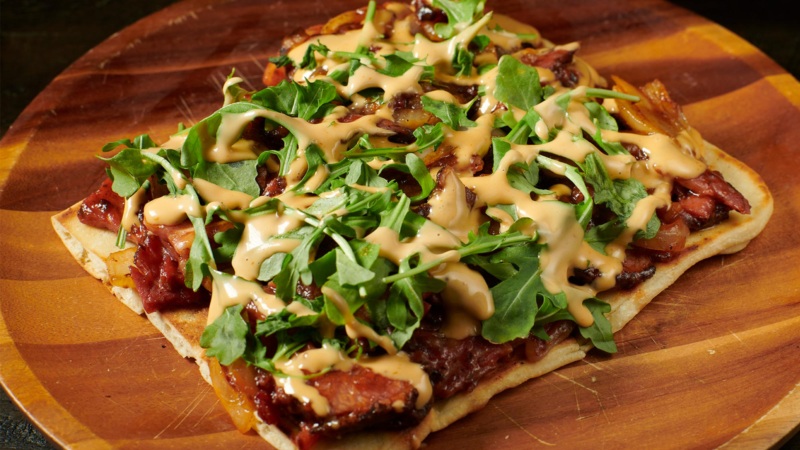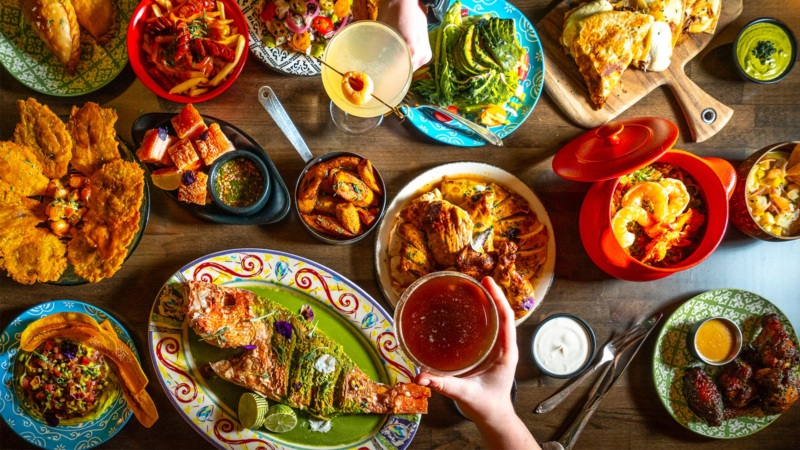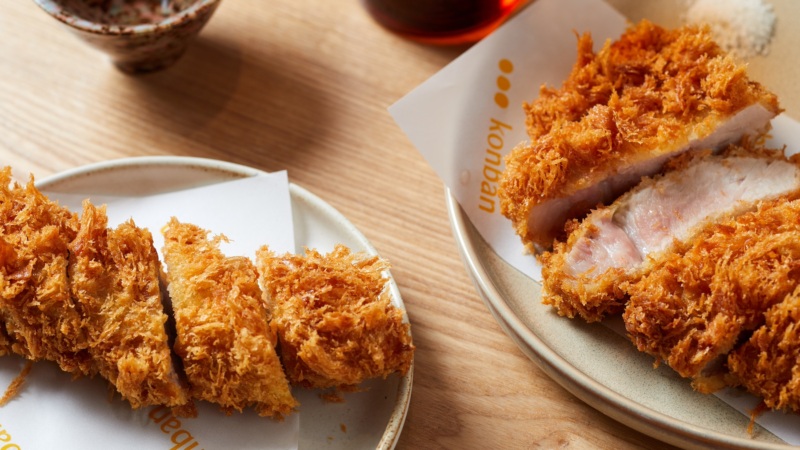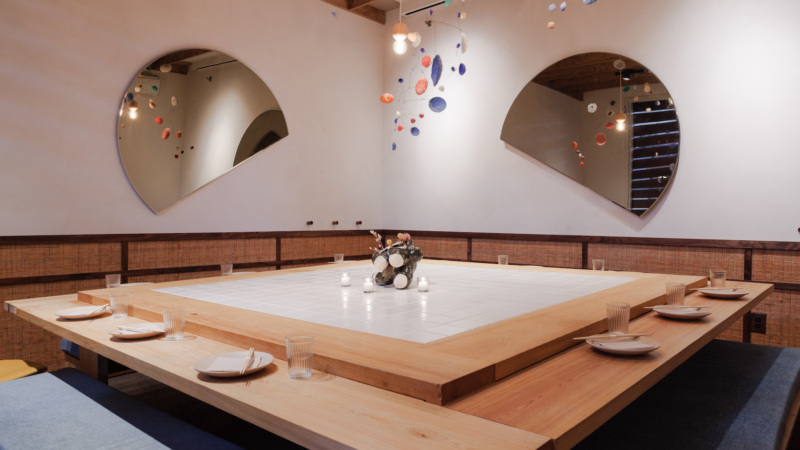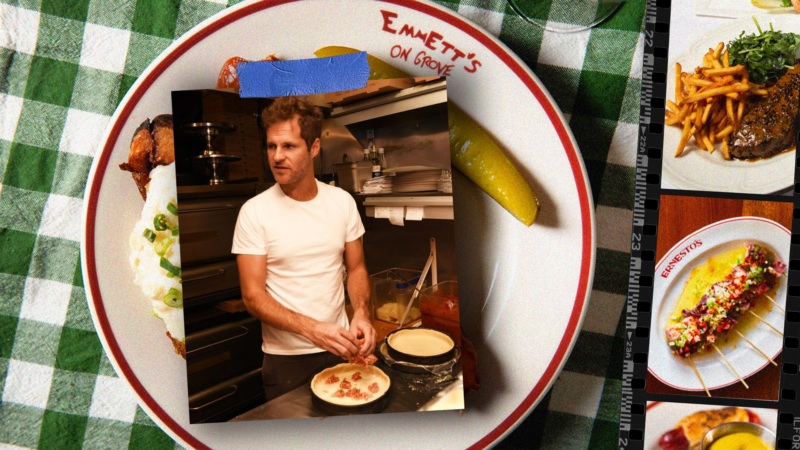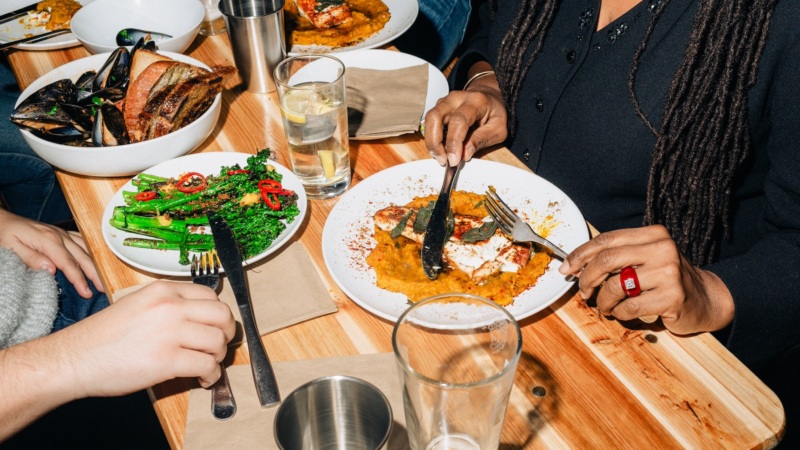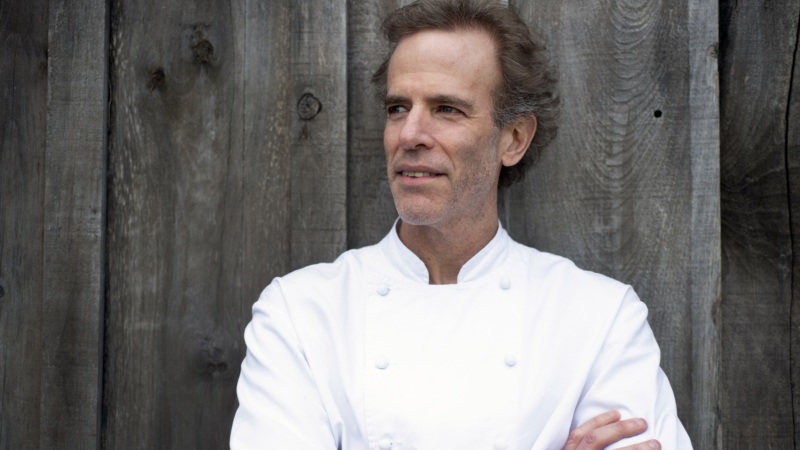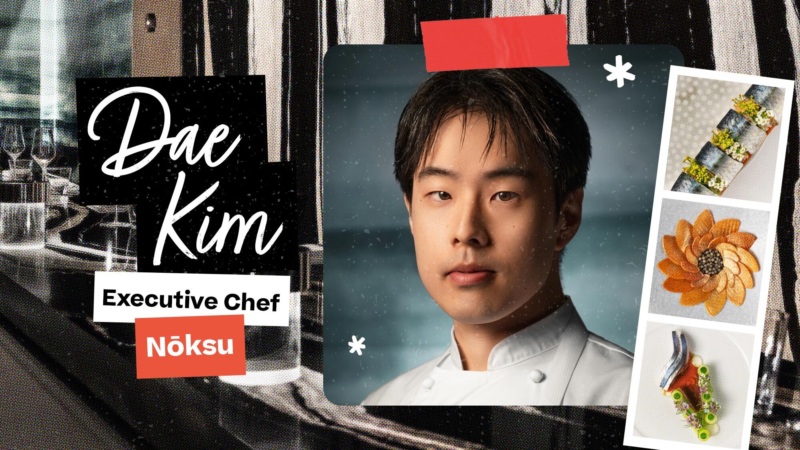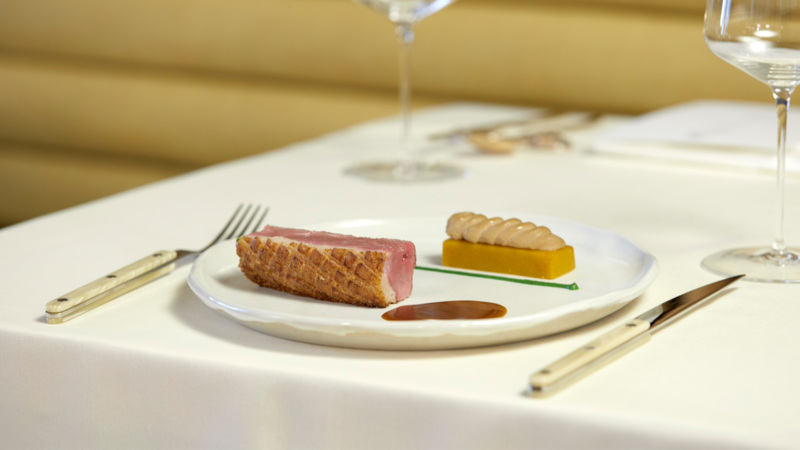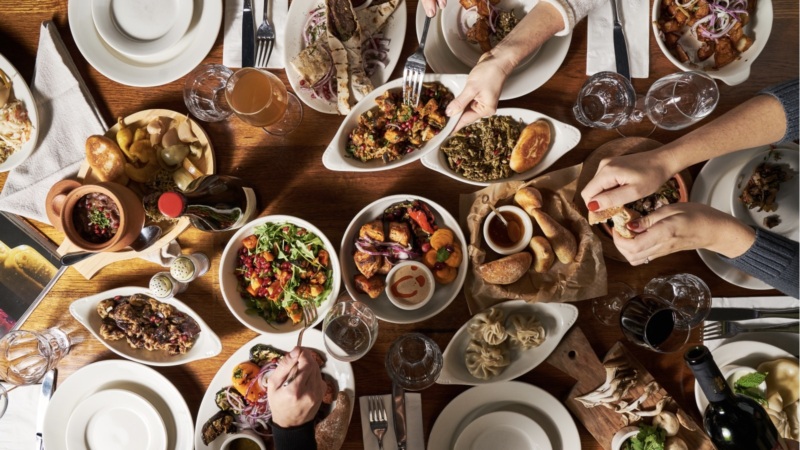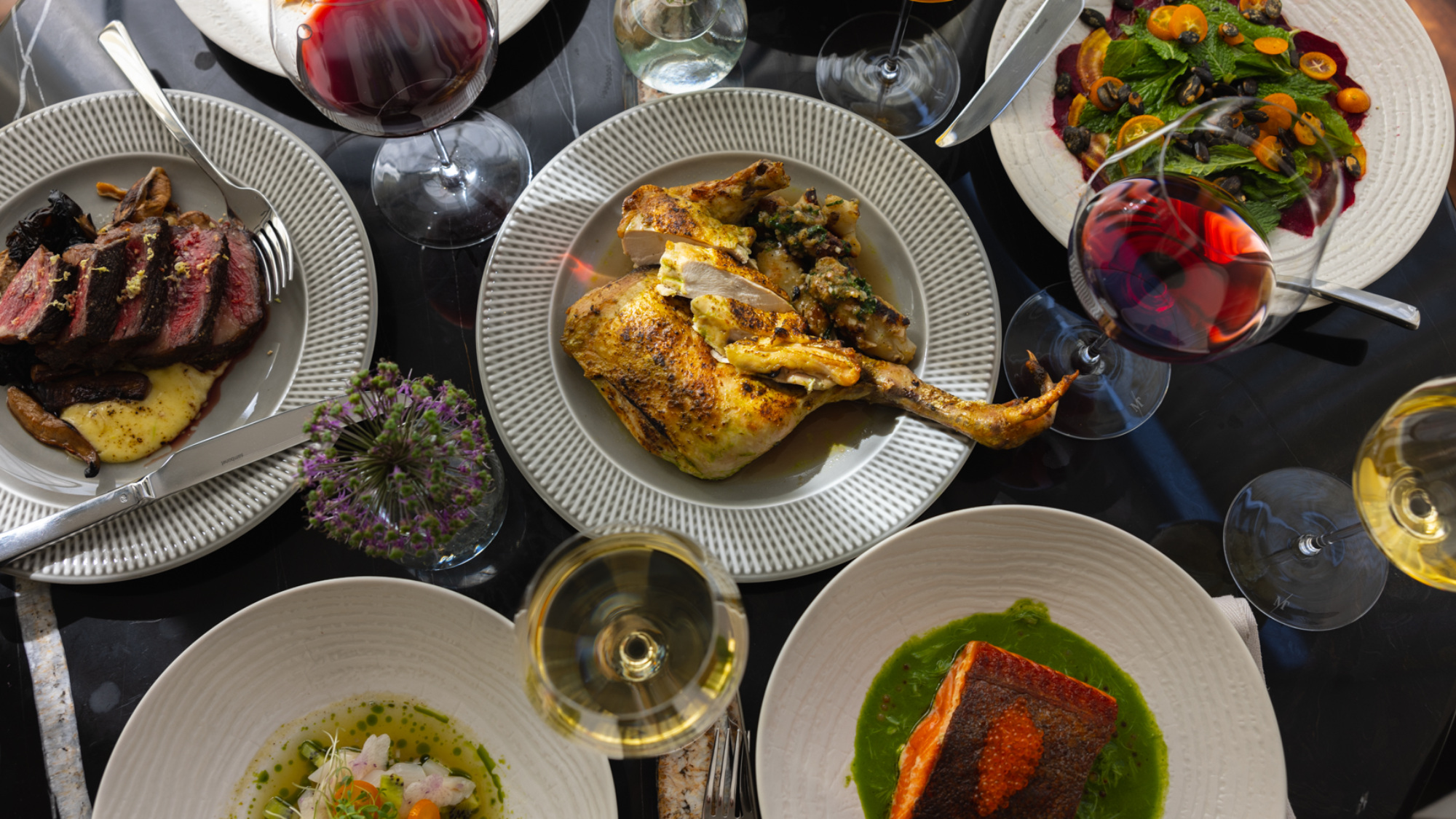
How Justine’s on Hudson Blends Filipino Flavors to Delicious Effect
Though Justine’s on Hudson bills itself as a wine bar, this West Village restaurant that opened in April is really an opportunity to have dinner in the cellar of one of the country’s foremost wine importers: Neal Rosenthal.
Helmed by chef Jeanne Jordan, who previously ran the kitchen at celebrated (and now-closed) New American restaurant, Mas (farmhouse), the menu at Justine’s draws on Jordan’s Filipino heritage, as seen in the raw marinated seafood preparations and a golden roast chicken — an ode to her mother — but also calls on the bounty of farm-fresh produce provided by owner Neal Rosenthal’s upstate farm, which includes eggs, lettuces, and soon, grapes.

“Neal’s vision was, with a hyper-seasonal menu, whatever he gets from the farm is what we cook during that week,” notes Jordan.
Justine Rosenthal, Neal’s daughter, is the restaurant’s namesake and restaurateur, who, in collaboration with Jordan, curates this intimate 30-seat wine bar.
The well-educated staff is there to help with any wine suggestions, like pairing a crémant du Jura sparkling rosé alongside any seafood crudo. Or noting how Justine’s signature roast chicken is fortified by a rich red Sancerre. What makes for an even more epic pairing? “[Neal will] bring his own [personal] bottles — a [recent] 1982 Nebbiolo was just insane,” Jordan says. The restaurant’s wine list is made up of wines imported by Rosenthal Wine Merchants, while the cocktail list features spirits from a variety of producers.
Here’s a closer look at five signature dishes on the menu that are not to be missed, along with suggested wine pairings from Neal Rosenthal himself.
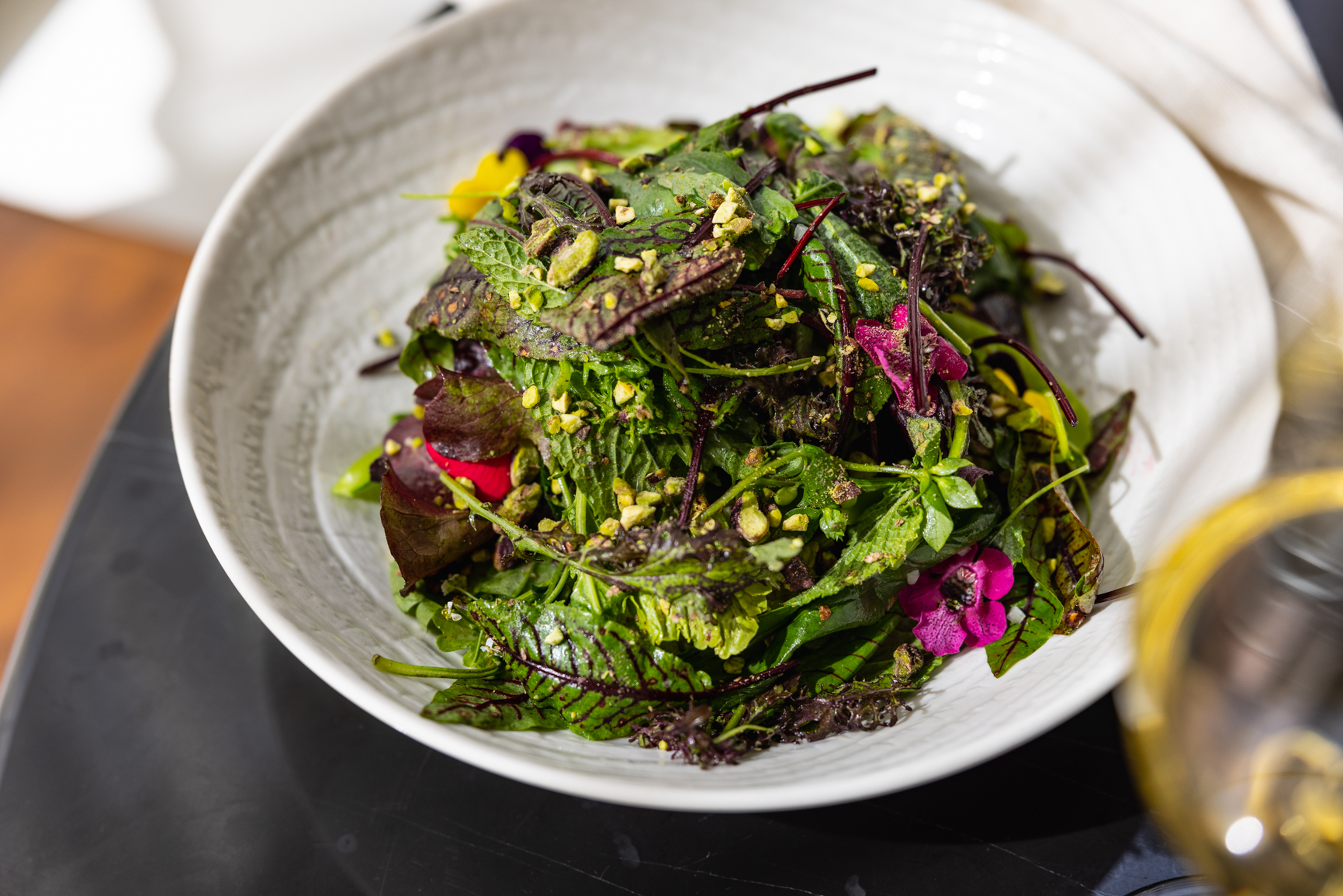

Mad Rose Salad
Most of the greens served at Justine’s are grown on Neal’s Dutchess County farm, and in fact, the titular lettuce is named after his specialty food business: Mad Rose. The vegetables are the real stars of the dish, ranging from tender snap peas to pungent radishes. A recent iteration played off pickled and fresh melons and cucumbers, with a salty creamy manouri cheese to complement the crunch. Whether she uses a mix of lettuces and chicories, for both crisp textures and bitter flavors, or a composition of field flowers and tender peas, Jordan has perfected a universal vinaigrette. To make it, she blanches lemon rinds, then blends them with lemon juice, lemon verbena, and olive oil for a smooth, bright salad dressing. “In September, we’ll definitely use more [raw and roasted] squash, [toasted] pepitas,” but it’s really at the whim of what’s growing, she notes.
To Pair: Rosenthal suggests the Crémant du Jura Rosé Brut by Domaine Overnoy-Crinquand. “It’s made with Ploussard grape by a family that has always farmed organically; it’s bone dry (brut zero) with a lovely pale rose color and vibrant peach-like fruitiness.”
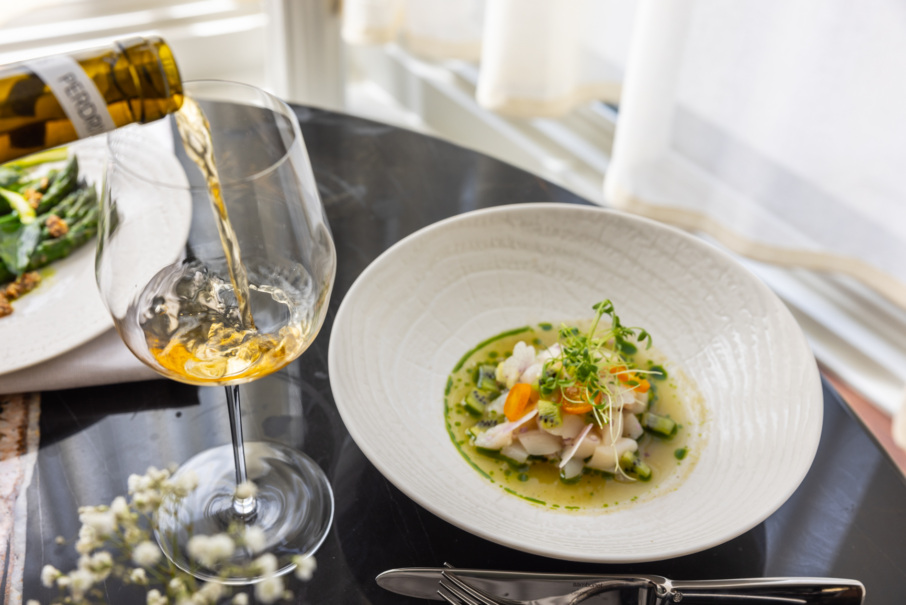

Seafood Crudo
Jordan’s raw seafood dishes are derivative of kinilaw, a.k.a. Filipino-style ceviche, which utilizes both vinegar and citrus to treat the fish. “My dad used to make kinilaw all the time,” she says. At Justine’s on Hudson, she serves a scallop ceviche, made with coconut milk, coconut vinegar, and ginger, similar to the one she grew up on, or swaps in sea bass. A recent version made use of fluke from Montauk, embellished with apricot, wasabi, and lime. “When apricots are in season, I love their sweetness and their floral [quality],” says Jordan. Lime is there for punch, wasabi for heat and color. “When guests eat it, their palate is refreshed for the next course,” says Jordan.
To Pair: Rosenthal recommends the Cassis Blanc by Domaine du Bagnol (2021). “It’s produced from Marsanne, Clairette, Ugni Blanc by the Genovesi family whose winery is in the heart of the fishing village of Cassis found on the shores of the Mediterranean, nearly seven-and-a-half-miles east of Marseille.”
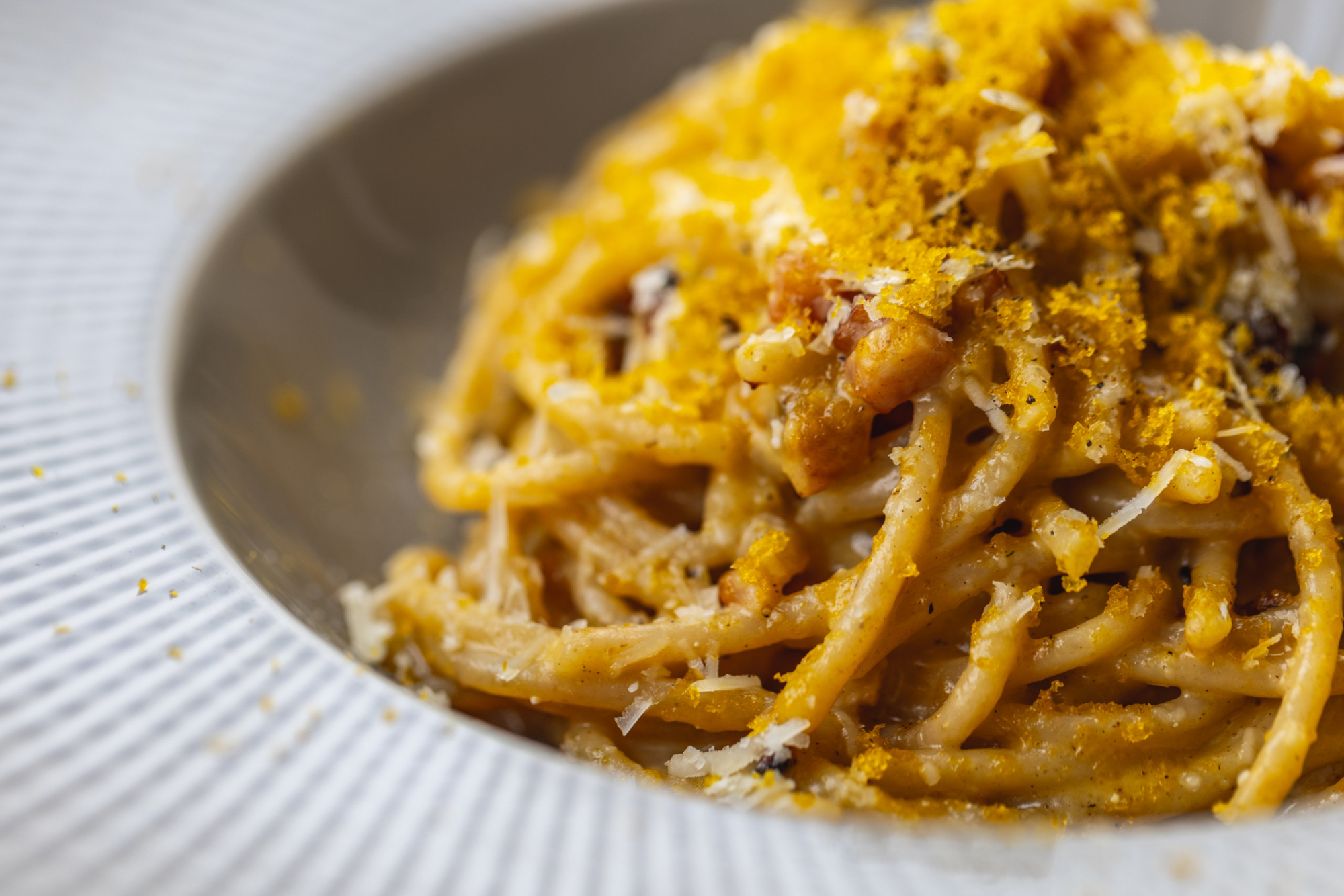

Bea Pasta
Paolo Bea, a prized winery in Rosenthal’s import portfolio, now also produces dried pasta. Durum wheat is planted amid the Umbrian hills of Montefalco, Italy, on 37 acres of land, a dozen of which are dedicated to Sagrantino, Sangiovese, and Montepulciano vineyards — much of the rest are his prized grains. Jordan rotates through pasta varieties from the winery, using pinwheeled capitelli, tube-shaped paccheri, and long ribbons of truffle tagliatelle.
“They’re made from [durum] wheat flour, but don’t have that whole wheat density or heaviness,” says Jordan. It’s also low in gluten. For her spicy truffle tagliatelle, Jordan tosses fresh crab with XO sauce (a spicy Chinese seafood sauce made with dried scallops), chiles, and lemon. While the pastas are Italian, the other ingredients are globally inspired. Jordan says, “We’ve done capitelli with curry leaves and pesto made of garlic scapes,” which she finishes with pistachios, parmesan, and lemon zest.
To Pair: Rosenthal says: “Of course, a Bea wine Arboreus 2015 Umbria Bianco, a long-maceration white wine with some age that has a nutty flavor profile, it’s quite full bodied with a complex range of aromatics.”
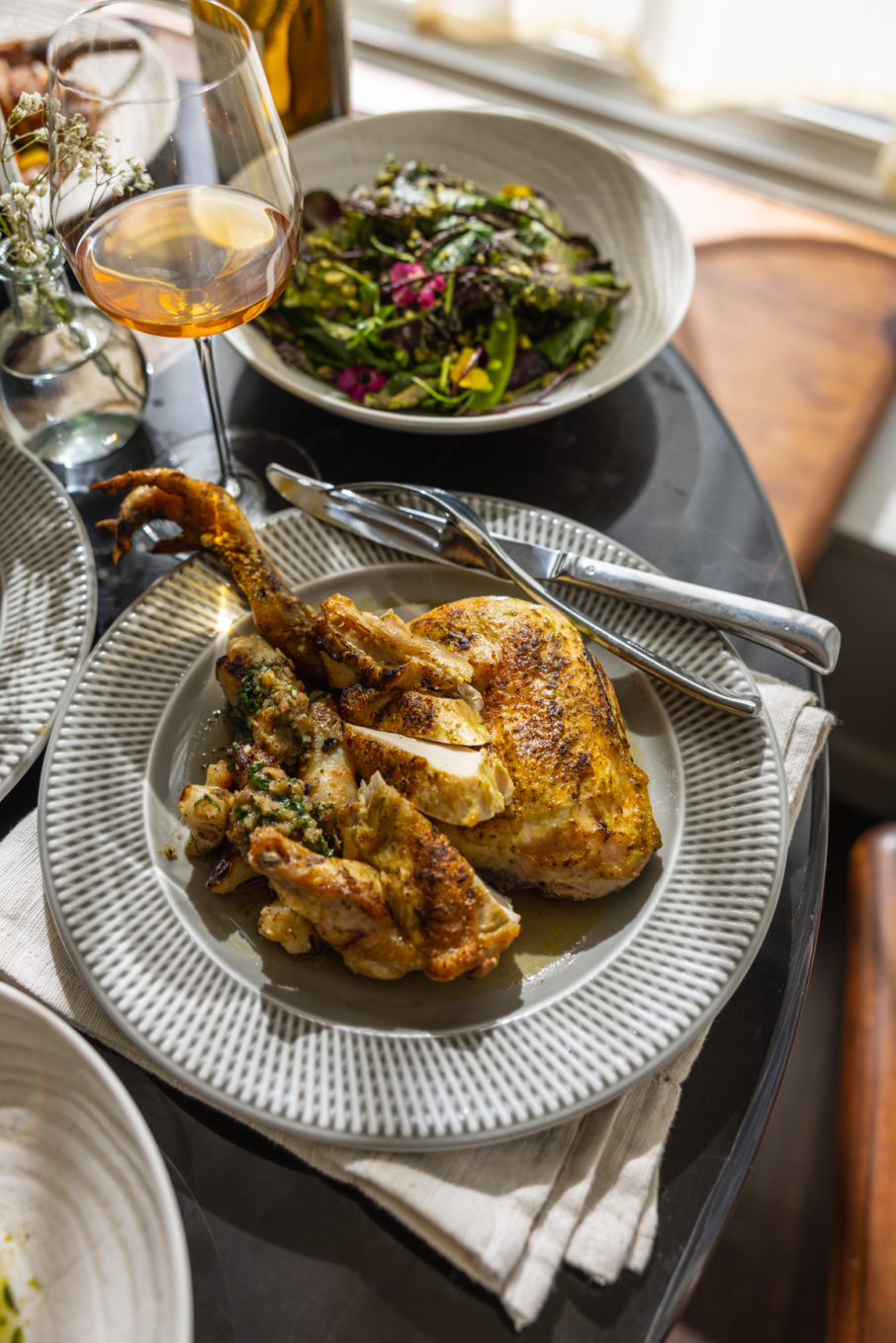

Golden Roast Chicken
Grilled over Japanese binchotan (charcoal) and served with black garlic, truffles, potatoes, and turnips, the sides for the chicken dish change with the season, but the dish never strays from its marinade.
Garlic, Knorr seasonings, dried oregano, and dried basil, are the primary players when it comes to the chicken’s golden hue and herbaceous palate. The use of Knorr seasonings is an ode to Jordan’s mom. “It’s very umami — it’s not as salty as soy sauce, but looks like it, and is almost mushroom-y” says Jordan. She considers the chicken to be a blend of two famous Filipino chicken dishes: salty and sour adobo and smoky grilled inasal.
Jordan uses New York’s beloved, family-owned, Hong Kong-style Bo Bo Chicken purveyor, keeping the feet on, and splitting the bird into halves, presenting a breast, leg and thigh. “I want our main course to be satisfying, generous. I don’t want people to feel like they didn’t have enough food — like my mother [would be worried about],” she jokes.
To Pair: Rosenthal would pair this with the Ghemme Riserva Costa del Salmino (Rovellotti) from 2015. “It’s a Nebbiolo-based wine from the Alto Piemonte produced by the masters of the appellation and aged for a minimum of three-and-a-half to four years in barrel, and aged further in bottle before release. It’s a complex, earthy wine with subtle tannins.”
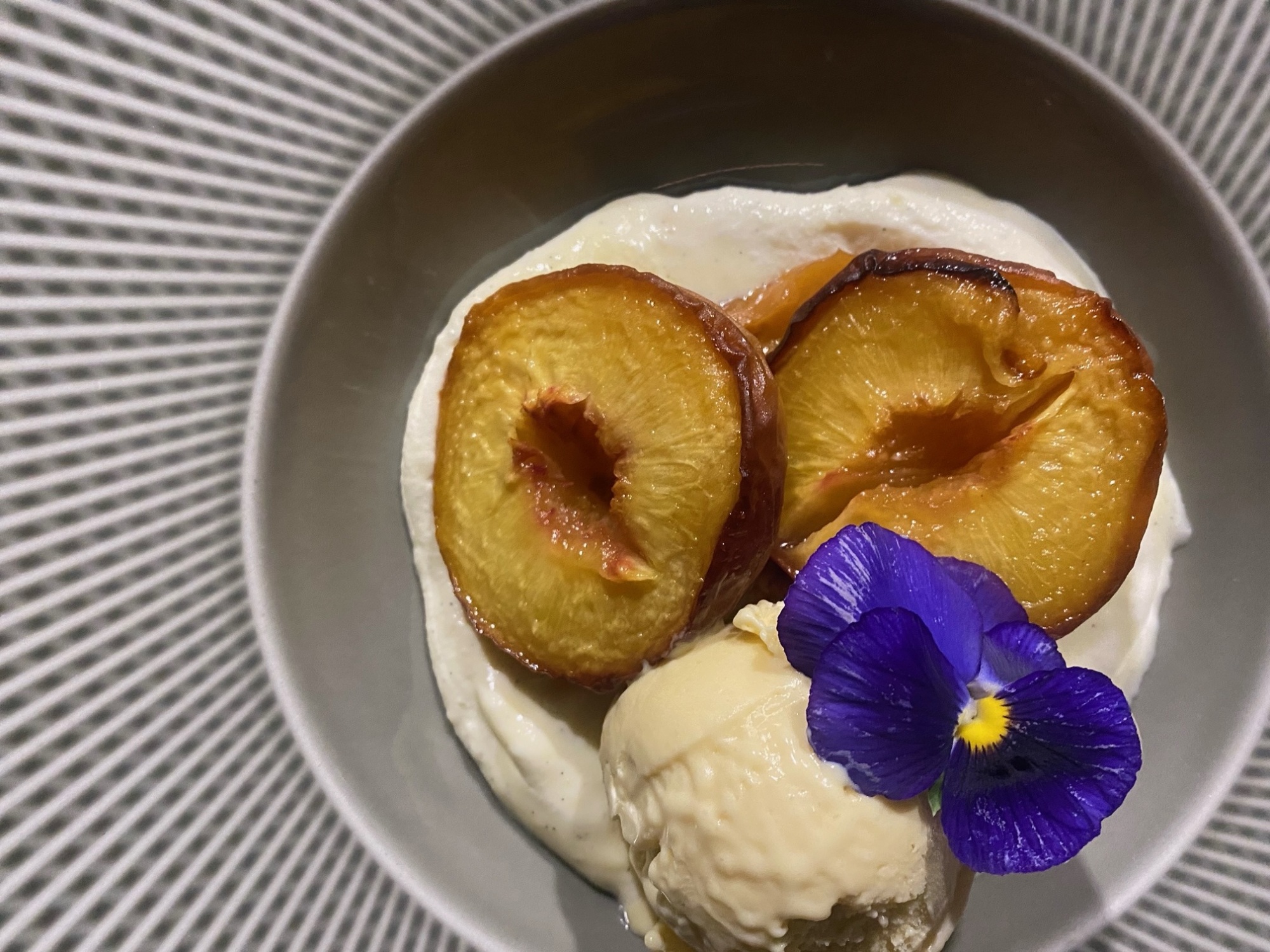
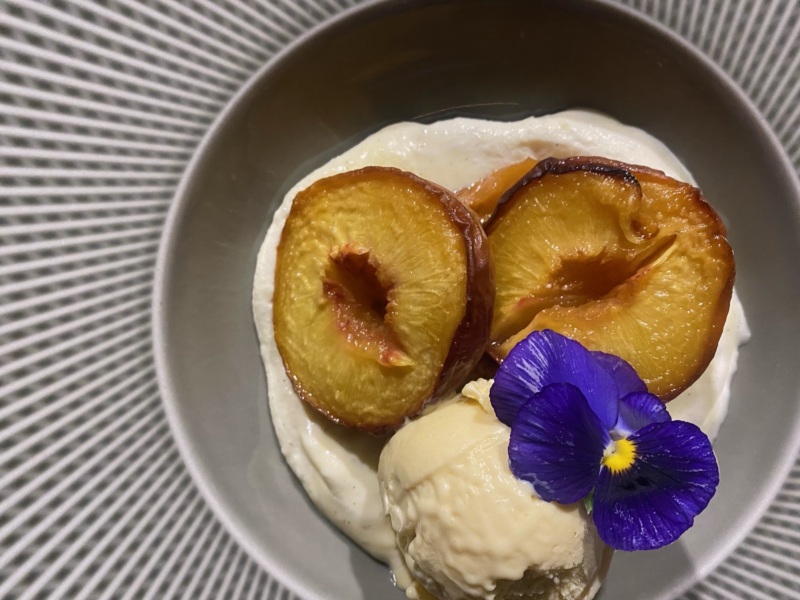
Custard/Affogato
“We’ve always had some kind of custard [on the menu],” says Jordan, “whether it’s goat cheese, crémeux, or the current corn pudding,” which Jordan folds whipped custard into for a lighter custard texture. “Filipinos love anything with sweet corn,” says Jordan, who adorns this recent iteration with peaches and parmesan ice cream. Rosenthal’s Mad Rose also imports Krumiri Rossi biscotti, a centuries-old Piedmontese treat, which comes alongside the restaurant’s affogato — a strong shot of espresso poured over a cooling scoop of vanilla ice cream which melts away any worries.
To Pair: If you want to splurge, Rosenthal says you can’t go wrong with a 1994 vintage of the Château de Fargues, Sauternes. “One of the greatest estates in the region, owned by the Lur Saluces family, former owners of Yquem and the long-time sister wine to Yquem as it is produced with the same exacting standards,” he says. “It has a touch of orange rind on the palate with a long and seductive finish with the lively acidity in perfect balance with the residual sweetness.”
Justine’s on Hudson is open for dinner from 5 to 10:30 p.m. Tuesdays through Saturdays.
Michael Harlan Turkell is a photographer, writer, and cookbook author. He’s also host of the Modernist Pizza Podcast, which explores the art, history, and science of pizza. Follow him on Instagram and Twitter. Follow Resy, too.


